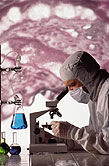
TUESDAY, Jan. 11 (HealthDay News) — Most recommendations on how to treat common infectious diseases are grounded in expert opinions or case reports, and not evidence from clinical trials, new research indicates.
That’s not necessarily a bad thing, according to a study appearing in the Jan. 10 issue of the Archives of Internal Medicine, but it may be a wake-up call for more attention to be paid to hard research on infectious disease.
“We were surprised to see that even though they represent a large body of data and a huge amount of work done by many others, that more than half of those individual recommendations are based on the lowest quality of evidence, which is either an expert opinion or a case report or case series,” said study co-author Dr. Ole Vielemeyer, an assistant professor of medicine in the division of infectious diseases and HIV medicine at Drexel University College of Medicine in Philadelphia.
The problem, he and others say, is that younger doctors in particular may look at these recommendations as something akin to gospel.
“Sometimes doctors-in-training think if it’s written in the guidelines, there must be strong evidence behind it,” said Vielemeyer. “They equate the two things without looking at the evidence behind it.”
“Guidelines are there to guide people. They’re not there to make decisions,” added Dr. Paola Lichtenberger, an assistant professor of clinical medicine in the division of infectious diseases at the University of Miami Miller School of Medicine. “They tell you what facts we know, what experts are doing and what’s the evidence behind them.”
Still, she said, “I do think that infectious diseases need more clinical trials. It’s quite a new field.”
These researchers took a close look at the underlying basis for 41 different clinical practice guidelines that were set between 1994 and May 2010 for the treatment of a number of leading infectious diseases such as such as bacterial meningitis, infectious diarrhea, Lyme disease and community-acquired pneumonia.
The 41 guidelines contained 4,218 individual recommendations, which the authors assessed on both quality and strength.
Fourteen percent of these were determined to have “level I evidence,” meaning they had at least one randomized clinical trial, the gold standard of science, to back them up; 31 percent had “level II” evidence, meaning evidence from one well-conducted study, even though it wasn’t a randomized controlled trial.
But more than half of the recommendations (55 percent) had only level III evidence, meaning the recommendations were based on the opinions of individual experts or panels, or case descriptions.
Globetrotters will be happy to know that travel medicine guidelines on infectious disease tended to have the highest quality of evidence behind them.
And the authors also found that updated guidelines did tend to contain more references than their predecessors, indicating that more studies are being done.
Except for HIV/AIDS, it is notoriously difficult to conduct good trials on infectious diseases, the experts said. Either there aren’t enough people that contract these illnesses, they’re difficult to diagnose or trials would simply be unethical to conduct — for example, whether hand washing might reduce the risk of hospital-acquired infections.
Although the current IDSA [Infectious Diseases Society of America] guidelines are “as good as the evidence out there in the literature,” Vielemeyer said, patients might get better treatment if there was more evidence to back up certain practices.
For example, he said, “there’s still overuse of antibiotics. Often it’s too long a duration and all these medications have side effects,” he said. “If we had good evidence that three days of antibiotics is enough rather than seven days, I think that would make a difference.”
Attorneys, too, might take note of how guidelines are formulated, Lichtenberger said.
“Lawyers assume that the guidelines are the last word [but] the guidelines are used to guide . . . they cannot in a single case tell you what to do,” she said. “That’s why the physician comes into the act and says, ‘Okay, for my patient the guidelines are appropriate or the guidelines definitely are not for [this patient].'”
More information
Find more on infectious diseases guidelines at the Infectious Diseases Society of America.

